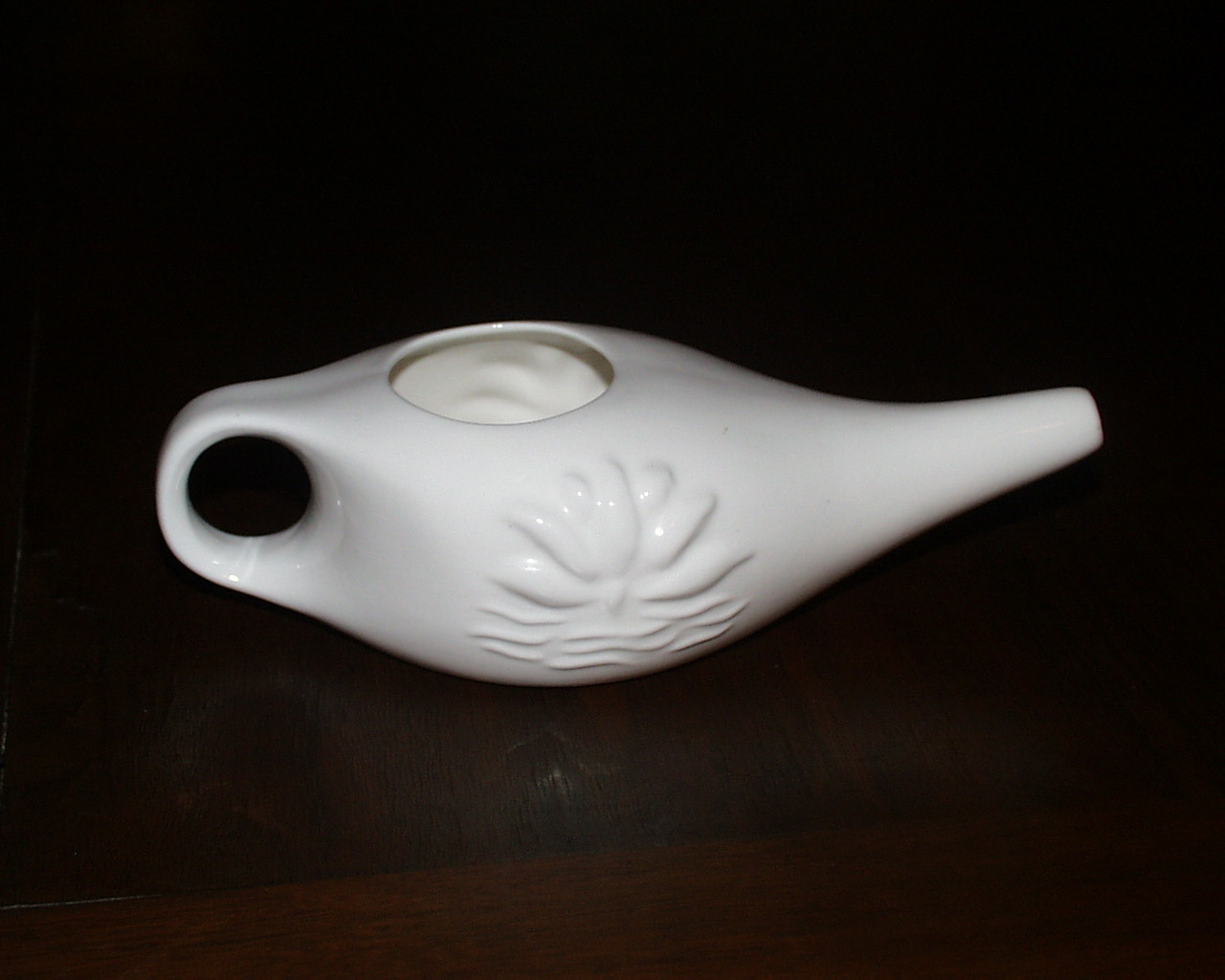Neti (Hatha Yoga) on:
[Wikipedia]
[Google]
[Amazon]
 Neti (
Neti (
 For this technique, sterilized and lukewarm isotonic
For this technique, sterilized and lukewarm isotonic
from yoga-age.com. It is also possible to sniff the water in so that it runs into the mouth, and to spit it out. In a more advanced reverse variant, the water is taken in through the mouth and snorted out of the nose.
 Neti (
Neti (Sanskrit
Sanskrit (; attributively , ; nominally , , ) is a classical language belonging to the Indo-Aryan branch of the Indo-European languages. It arose in South Asia after its predecessor languages had diffused there from the northwest in the late ...
: नेती ''netī'') is an important part of Shatkarma
The shatkarmas (Sanskrit: षटकर्म ''ṣaṭkarma'', literally ''six actions''), also known as shatkriyas,Hatha Yoga Pradipika
The ''Haṭha Yoga Pradīpikā'' ( or Light on Hatha Yoga) is a classic fifteenth-century Sanskrit manual on haṭha yoga, written by Svātmārāma, who connects the teaching's lineage to Matsyendranath of the Nathas. It is among the most inf ...
and other sources usually attribute to Neti many beneficial effects that range from profound physiological ones on the body, mind and personality to even clairvoyance
Clairvoyance (; ) is the magical ability to gain information about an object, person, location, or physical event through extrasensory perception. Any person who is claimed to have such ability is said to be a clairvoyant () ("one who sees cl ...
. The two main variants are jala neti (जलनेति) using water and the more advanced sutra neti (सूत्रनेति) using string.
Jala neti
salt water
Saline water (more commonly known as salt water) is water that contains a high concentration of dissolved salts (mainly sodium chloride). On the United States Geological Survey (USGS) salinity scale, saline water is saltier than brackish water, ...
is poured into one nostril, so that it leaves through the other. The procedure is then repeated on the other side, and the nose is dried by bending forward and by rapid breathing.Jala & Sutra Neti Instructionsfrom yoga-age.com. It is also possible to sniff the water in so that it runs into the mouth, and to spit it out. In a more advanced reverse variant, the water is taken in through the mouth and snorted out of the nose.
Sutra neti
In sutra neti, a length of wet string or thin surgical tubing is carefully and gently inserted through the nose and into the mouth. The end is then pulled out of the mouth and while holding both ends at once the string is alternately pulled in and out of the nose andsinus
Sinus may refer to:
Anatomy
* Sinus (anatomy), a sac or cavity in any organ or tissue
** Paranasal sinuses, air cavities in the cranial bones, especially those near the nose, including:
*** Maxillary sinus, is the largest of the paranasal sinuses, ...
es. It is used to clear the nose and also to remove nasal polyp
Nasal polyps (NP) are noncancerous growths within the nose or sinuses. Symptoms include trouble breathing through the nose, loss of smell, decreased taste, post nasal drip, and a runny nose. The growths are sac-like, movable, and nontender, t ...
s.
Sutra neti is an advanced form of yogic nasal cleansing and requires an experienced teacher. Sensations of gagging, nausea, and weakness may occur. In case of persistent blockage after jala neti, sutra neti should only be performed after a medical consultation.
Sutra neti is a nasal cleansing yoga exercise wherein the nasal area and outer respiratory regions are decongested with the help of soft thread. Initially, the soft thread is inserted through one nostril and tries to bring out through the mouth. The same process should be repeated with another nostril. After having mastery of the process, it can be inserted through one nostril and try to make it out through another nostril. One thing should be kept in mind is that it should always be practiced under the supervision of a yoga expert.
For the practice of sutra neti, it is better to use cotton thread, which should be carefully twisted. Before practicing, it should be carefully checked for knots or dust particles as they can harm the soft nasal region and also cause bleeding. Before using the thread, it should be soaked properly in water. A thin rubber catheter can also be used in place of thread. Cotton thread can be used having 4 mm width and being around 36 cm long (long enough to pass down the nose and reach out through the mouth). For beginning users a thin rubber catheter is preferred as it’s more lubricated compared to a cotton thread, so it easily slides more through nasal passages. While using cotton thread for Sutra neti, make sure to lubricate it using beeswax (or any other agent) otherwise it can produce a sense of nausea.
Some children are diagnosed with nasal allergies as early as age 2 and could use nasal rinsing devices at that time (only about Jal Neti Kriya) if a pediatrician recommends it, however very young children might not tolerate the procedure. Whether for a child or adult, talk to your health care provider to determine whether nasal rinsing will be safe or effective for your condition.
Notes
Further reading
* * * {{Yoga Hygiene Kriyas Shatkarmas